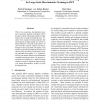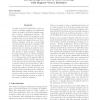801 search results - page 2 / 161 » The Inefficiency of Batch Training for Large Training Sets |
ACL
2012
11 years 8 months ago
2012
With a few exceptions, discriminative training in statistical machine translation (SMT) has been content with tuning weights for large feature sets on small development data. Evid...
CVPR
2012
IEEE
11 years 8 months ago
2012
IEEE
The use of statistical pattern recognition models to segment the left ventricle of the heart in ultrasound images has gained substantial attention over the last few years. The mai...
ICML
2003
IEEE
14 years 6 months ago
2003
IEEE
In many real world applications, active selection of training examples can significantly reduce the number of labelled training examples to learn a classification function. Differ...
BMCBI
2005
13 years 5 months ago
2005
Background: The MEDLINE database contains over 12 million references to scientific literature, ut 3/4 of recent articles including an abstract of the publication. Retrieval of ent...
ICPR
2004
IEEE
14 years 6 months ago
2004
IEEE
Gesture recognition is a difficult task in computer vision due to the numerous degrees of freedom of a human hand. Fortunately, human gesture covers only a small part of the theor...


